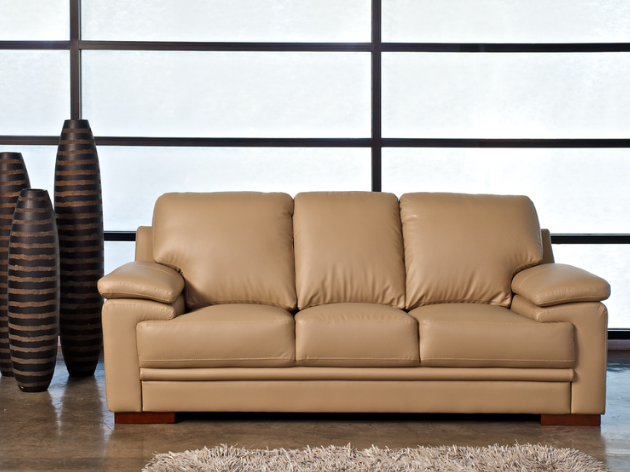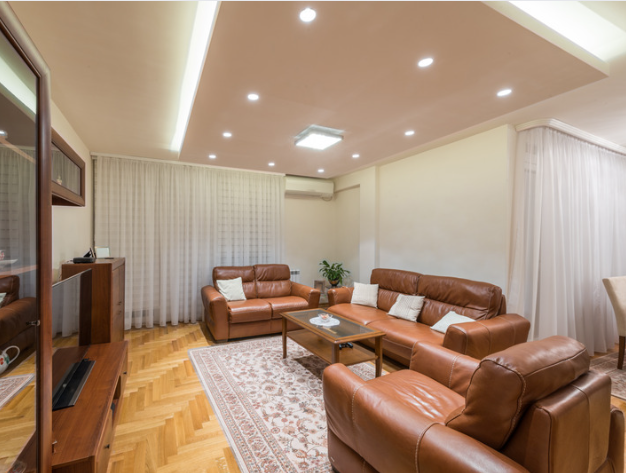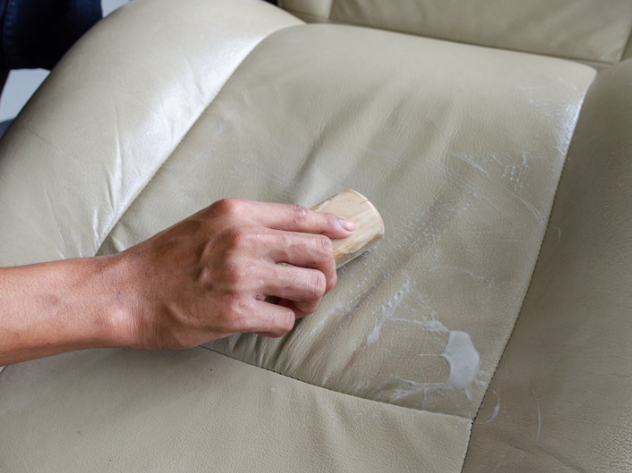Just bought a leather sofa and you’re already regretting the colour? Or maybe your leather couch is faded, and needs some work to bring it back to the way it used to look? Either way, a colour change is in order, right?
So, how do you do it? Thankfully, the process is easy enough to do. Follow the advice in this guide and you’ll be able to transform your leather sofas in almost no time at all. Better yet, the advice here largely applies to all leather furniture, leather car seats, and even leather clothes. You might need different products, but the process is often the same.
Ready to find out how to change the color of your leather sofa? Then read on below!
Is It Really Possible To Change The Color Of Your Leather Sofas?
Yes! Changing your leather sofa from a boring old dark brown to a bright red is possible (or whichever colour you fancy, of course). Want a new dark color or a brighter, lighter color? Then it’s possible. You can transform your leather sofa with ease.
All you need is a leather colour in mind, the right products to achieve it, and the perfect process to follow, and you can re colour and re spray your furniture and completely change the way it looks!

Which Leather Furniture/Products Can Have Their Colour Changed?
It isn’t just your leather sofa that can be transformed with the right leather dye products. Want to change your sofa, your leather seat cushion, car interior, clothes? Any leather product can have its colour changed. ANY. So transform your entire leather suite, if you like!
All you need to do is ensure you have the right products for the job. Now, the process and products we’ll discuss below are deliberately general, and that’s because there are many different products out there that you can purchase for different types of leather. A semi aniline leather might need to be treated differently from other leather types, for example. Picking the right products for your leather is key.
So, a word of warning. Make sure you check the products you’re buying are appropriate for your leather sofa. And even if it says it is – ALWAYS patch test each product on a lesser seen area of your couch, so if anything goes wrong it won’t ruin the look of your entire couch.
With that warning out of the way, let’s take a look at the products you will need!

Leather Colour Change Products
Below is a list of everything you will need to achieve the perfect leather colour change:
- leather cleaner
- leather prep/etching fluid
- sandpaper/abrasive pad
- leather dye
- leather sealant
- applicator sponge/wool dauber
- clean cloths
- spray gun (optional)
- hair dryer
- cotton wool balls
- repair kit (for creased and cracked areas where you might need to restore leather top coat – you can use this kit at around stage 3 of our how to guide below, making sure any patchwork is done before you dye the sofa)
- gloves
- drop cloths/tarp to protect surrounding area
- masking tape
These products will ensure you have got the leather ready for the colour change, and allow you to follow the correct procedure for perfect results! You’ll also be able to buy the majority of them in one handy leather colourant kit, so make sure you shop sensibly so you don’t pay more than you have to as well. Many brands offer helpful kits with almost everything you need.
Step-By-Step Guide To Changing The Colour Of Your Leather Sofa
The right leather prep is crucial when changing the leather colour of any product or furniture, but especially so when you’re dealing with a piece as large as your leather sofa. So to achieve the perfect leather finish, you need to start well!
Before You Start
The key here is making sure that you and the area you are working in are both ready for the task at hand. That means making sure you wear gloves and clothes you don’t mind getting dirty. You’ll also need to use your protective coverings and masking tape to protect the area you’re working in from accidentally getting products on them that you don’t mean to. Excess dye is possible when applying dye to your sofa, so make sure it can’t drip anywhere like the floor.
Once the area and yourself are protected, you can get to work. Just make sure you do all of this in a well-ventilated area to prevent the build up of products as you work, especially if you’re using a spray gun to apply the products.
1: Leather Cleaning
You don’t want to create more stress for yourself when dyeing any leather, so the very first thing you should do is clean it. By cleaning the leather, you ensure that any old dirt or grime is removed, meaning the following products can stick to the leather much better, providing the perfect leather finish.
Start by applying a thin coat of leather cleaner. You can use bought products, like foaming cleaners designed specifically for leather, or simply make use of rubbing alcohol cleaner or soapy water. An alcohol cleaner works well, but be aware that foam cleaners tend to go deeper into the leather than a standard alcohol cleaner to lift the dirt and grime right off. If your leather colour is particularly marred by dirt, then a foam cleaner might be best.
When used in a correct and sparing way, you’ll notice that overtime the cloth you use to wipe over the sofa with the cleaner will eventually wipe away clean. When this happens, stop using the cleaner. You might only need to pour a small amount of the cleaner on to the cloth to see this result, or you might need multiple coats. Just keep going until the cloth wipes away clean.
Just apply light pressure or use a soft cleaning brush to help work the product into the sofa if you aren’t applying with an applicator sponge or cloth. Whatever you use will yield just as successful results. The key here is getting the leather clean to start with.

2: Sanding The Leather
Once clean, it’s time to sand. You’ll need to completely cover all areas of the couch here, from seating cushions to the backrest. The reason sanding the leather is a good idea here is that it helps remove the old manufacturers finish. Any satin finish, matt finish, or gloss finish can be a nightmare when trying to colour change leather, because it acts as a sort of shield against dye.
Don’t apply too much pressure as you rub the leather with your sanding paper (make sure the sanding paper is fine, too), you’re simply trying to make the leather more susceptible to subsequent coats of product you’ll use below. Just give the leather a light sanding, working a little harder on any distinctive creases, and eventually the slight shine of the manufacturers finish will fade, and you’ll know it’s time to move on.
3: Etching/Prepping Fluid
After finishing sanding the leather, it’s usually a good idea to use leather cleaner again to remove any of the debris. A cloth dampened in alcohol cleaner is a great idea here because it’ll help the fine bits of sanded leather stick to the cloth to be discarded.
Once completely clean and completely dry, you can move on to the etching or prepping fluid (some manufacturers use different terms – essentially the product is a leather prep fluid designed to act as a primer for the other products to come – whilst also helping remove the rest of the old finish).
It’s really important that you find the right leather prep fluid though. Using something that’s too strong can result in damage to your leather – so it’s really important you patch test this product too.
When you’re happy with the product you’ve picked out, simply evenly coat your sofa with the leather prep fluid. Then dry it thoroughly with a hair dryer, and apply several coats, drying between each application.
By using more coats of the prepping fluid, you can guarantee that the other products you’ll use to get a different colour for your leather will work better, providing you with a better finished product too.
From this point on, all of the products will need a base coat, followed by a second coat, and sometimes more before a final coat. Always apply in thin layers, because the aim here is to build the products up for the colour change. Consult your product information on the bottle of the prepping fluid to determine how many coats you will need to apply after the first coat.
A great way to use the leather prepping fluid (designed to further remove the previous sealant and leather finish) is with two cotton wool balls and an abrasive pad. This will ensure the product works into the leather well. As soon as pigment shows on the cotton wool and abrasive pad, stop. This is a sign that the leather finish has come away, and the sofa is ready for the first coat of dye.
Once you’ve used the leather prep, wipe the chair down again with a cleaner once dry. Ensure the couch is dry again before moving onto the leather dye.
4: Leather Dye Application
Whether it’s a light color or a darker color, the key to a successful color change is in the building of the colour. One coat won’t do it.
If you’re using a spray here, it’s more important than ever to ensure the surrounding area is protected and the area you’re working in is well-ventilated.
Apply the first layer of leather dye with a cloth or spray, making sure it’s a thin coat. Use a hair dryer to help it dry completely. If it looks patchy, don’t worry. You still need to build more colour.
Simply repeat the process as many times as needed until the leather has achieved the desired colour. There’s no telling how many coats this might take. If it’s a lighter finish you’re looking for, then you’ll need to apply less of the colourant than a darker finish, for example. The key here is to not go too far. You can always build more, but you can’t take dye away once it’s on.
As soon as your leather sofa looks like you want it to, stop. Then use a hair dryer to dry it once more.
5: Leather Finish
Now that the leather is looking the way you want it to, the only thing left to do is finish it with a sealant that’ll help protect the work you’ve done. Most people will opt for a matt finish here, but if you like the shine of a gloss or satin finish then look for a product that will provide this.
Simply apply the sealant or finisher using the product’s instructions. Again, you’ll need a few different applications, making sure you wipe in different directions each time to ensure a thorough coverage.
As soon as you’re happy with the finish and are satisfied that the work you’ve done is well protected, it’s time to stop.
All that’s left for you to do now is allow the whole project to set. This will take at least 24 hours. Ensure nobody uses the leather sofa, or car seats (whatever you’ve dyed) during this time. If they do, there may be some dye transfer and they could potentially ruin your hard work. As soon as the whole project is set, you can use the leather like usual.
Change The Color Of Your Leather Couch: A Review
Changing the colour of your leather sofa is so much easier than people first realise. If we were to provide a quick overview to help you remember, it would look a little something like this:
- Clean your leather
- Sand it down and use leather preparation fluid to help remove the old finish
- Use leather dye slowly, in thin layers, drying in between each application until the leather looks as you want it to
- Once happy, use a leather sealant to protect your hard work
It really is that easy. The real key to success, though, is finding the right products for the job. Remember to always patch test them before using on your couch, and always look for leather specific products designed for your type of leather.
But with the right products and our simple, easy to follow advice, you’ll have a transformed leather sofa in no time at all!
